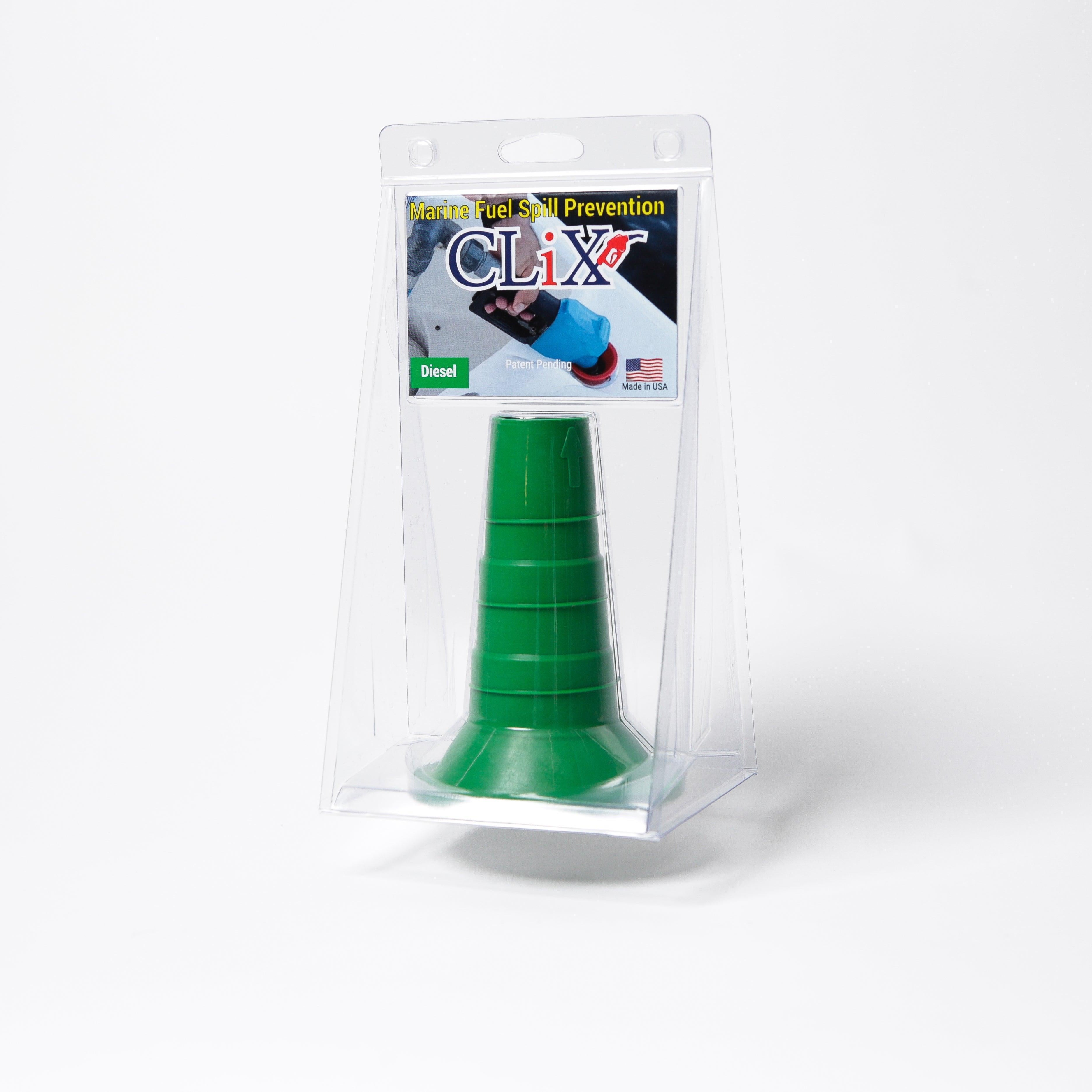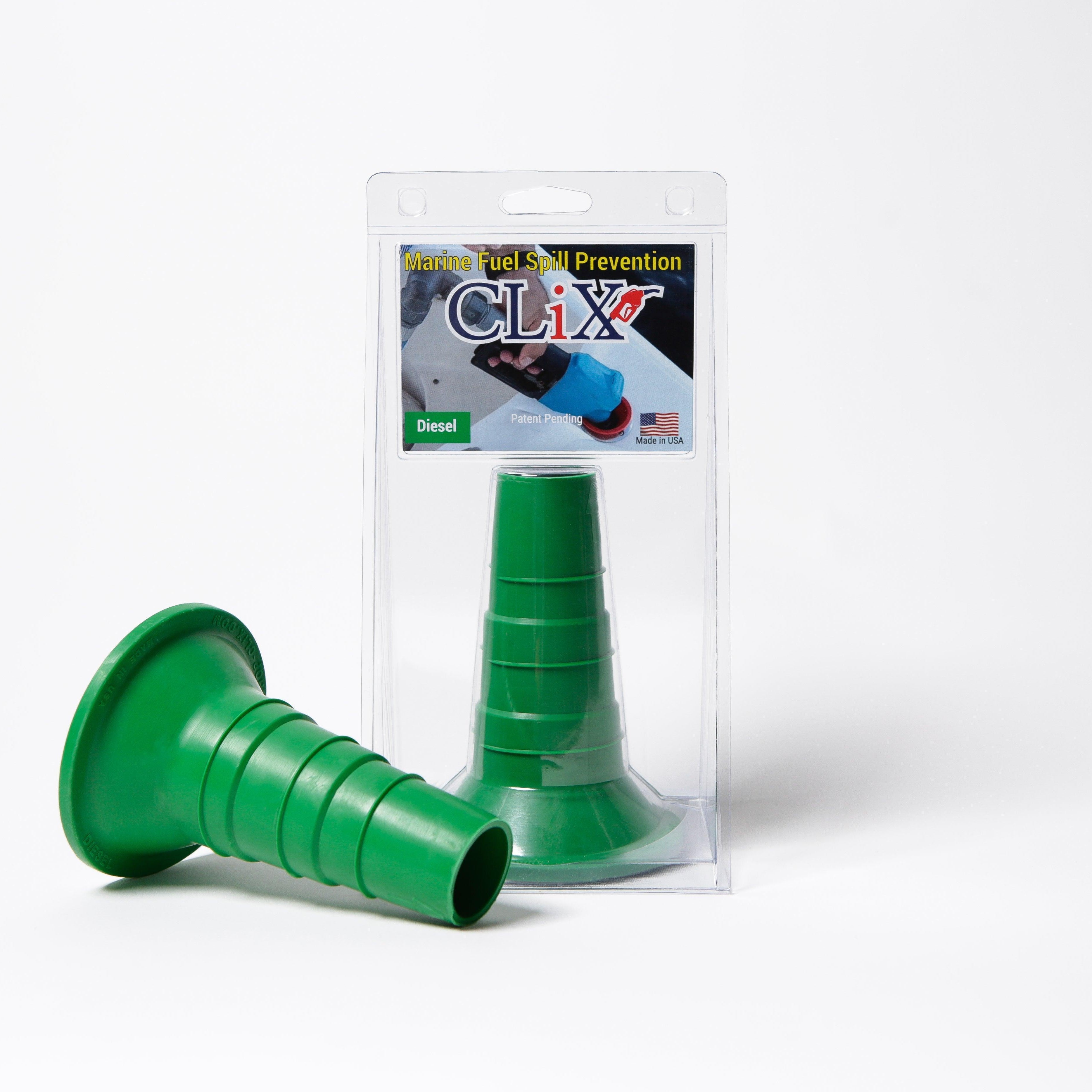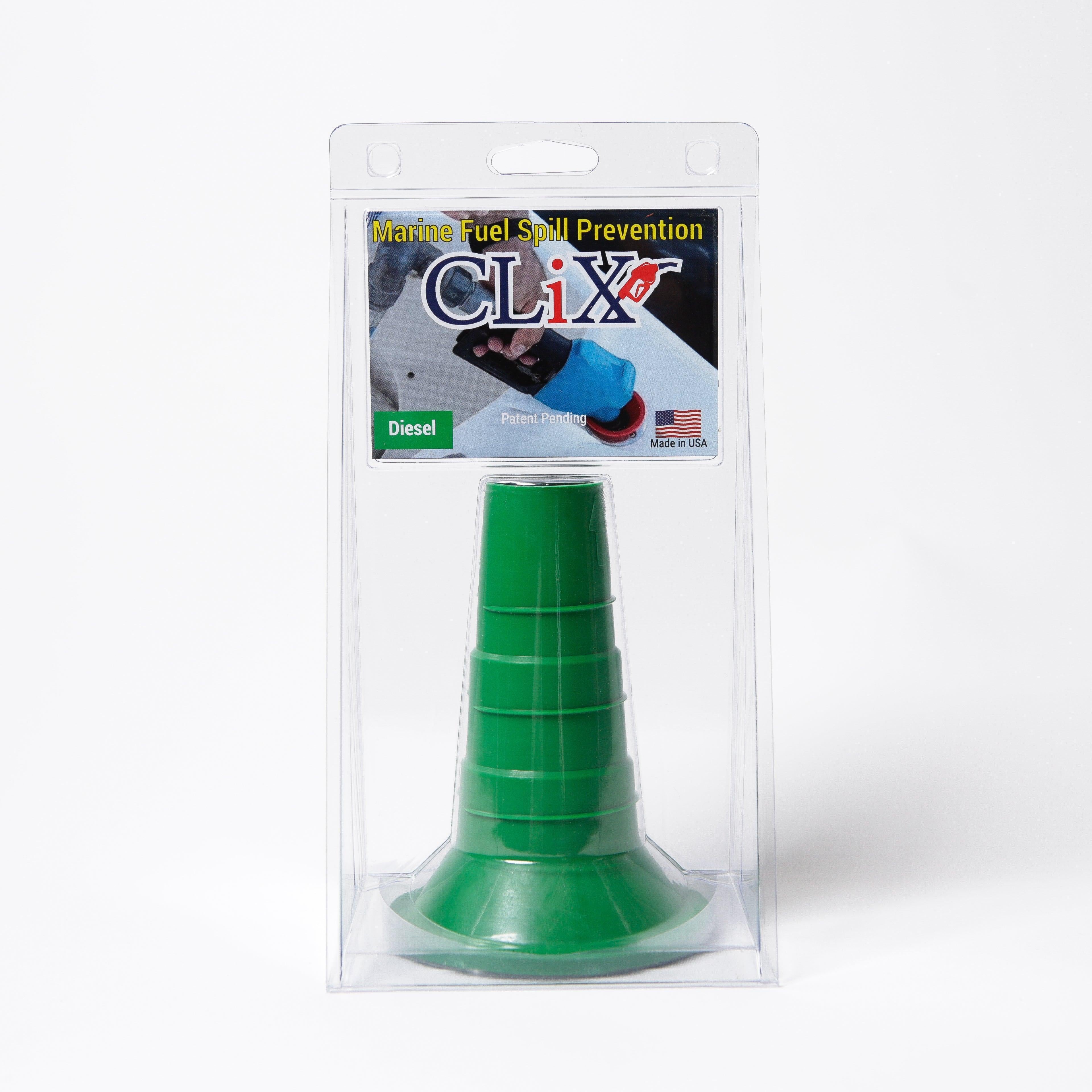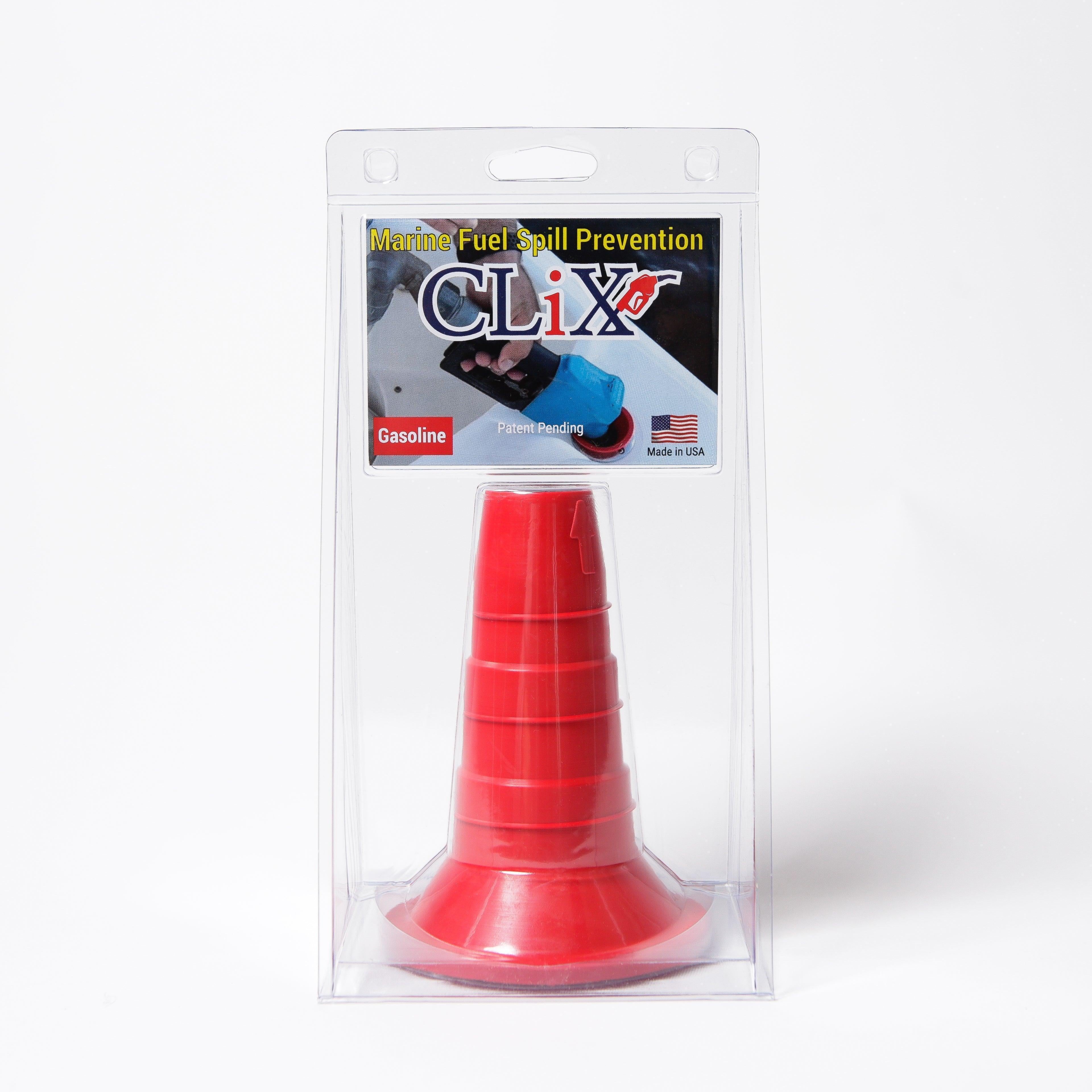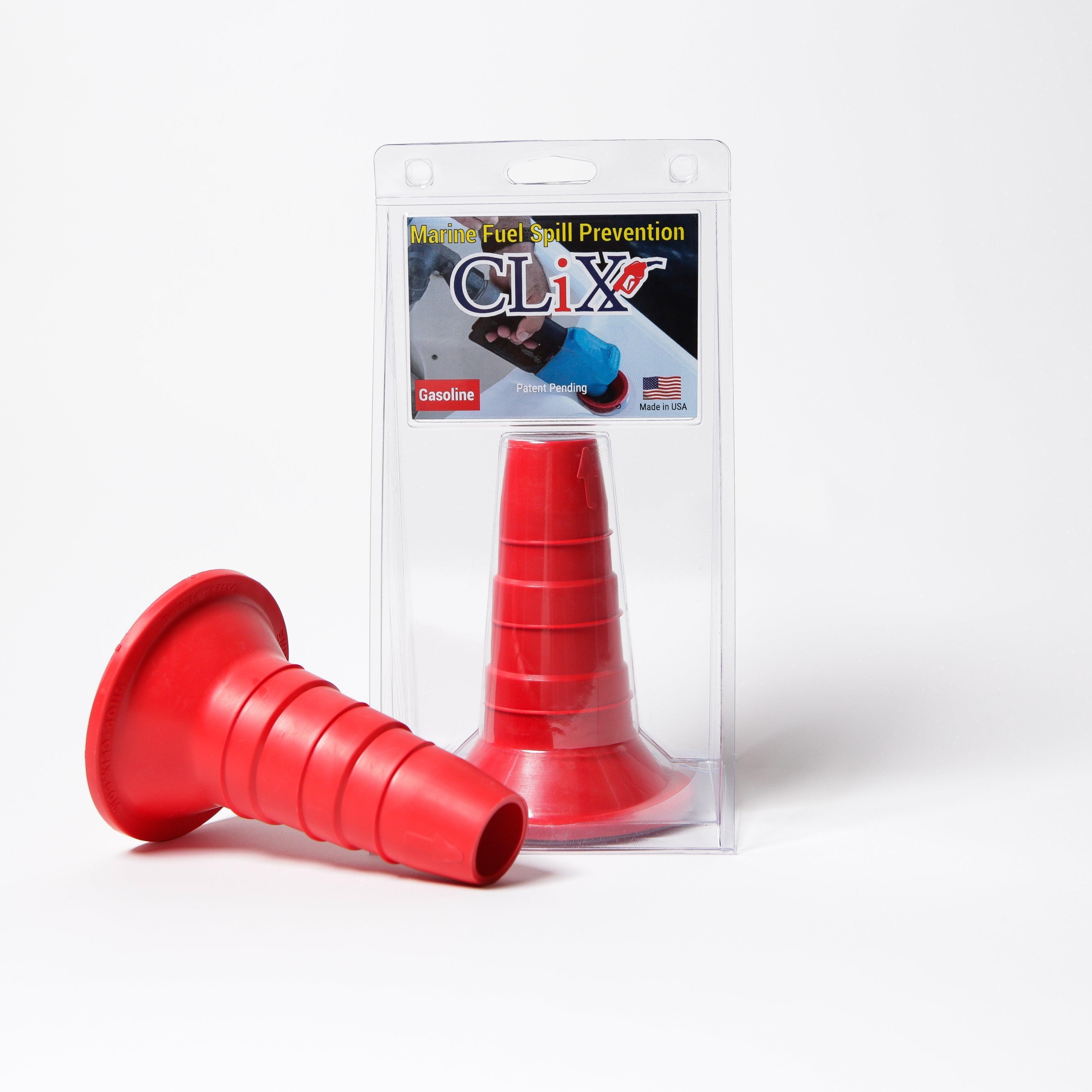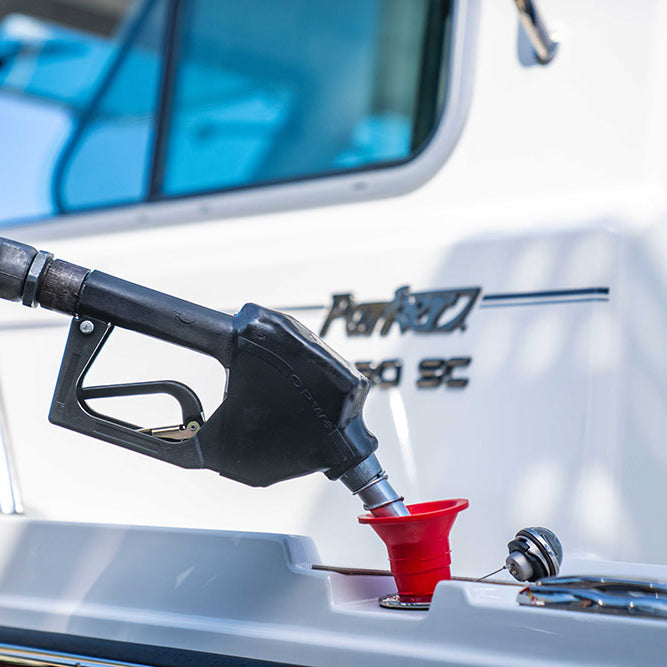For a lot of boaters, heading out for a perfect day on the water means having a 10 gallon gas canister on board. It’s that sweet spot for reserve fuel—big enough to give you real peace of mind but not so heavy you need a forklift to get it from your truck to the dock. This size just nails the balance between extending your range and practical, everyday portability.
Why a 10 Gallon Gas Canister Is Your Best Friend on the Water
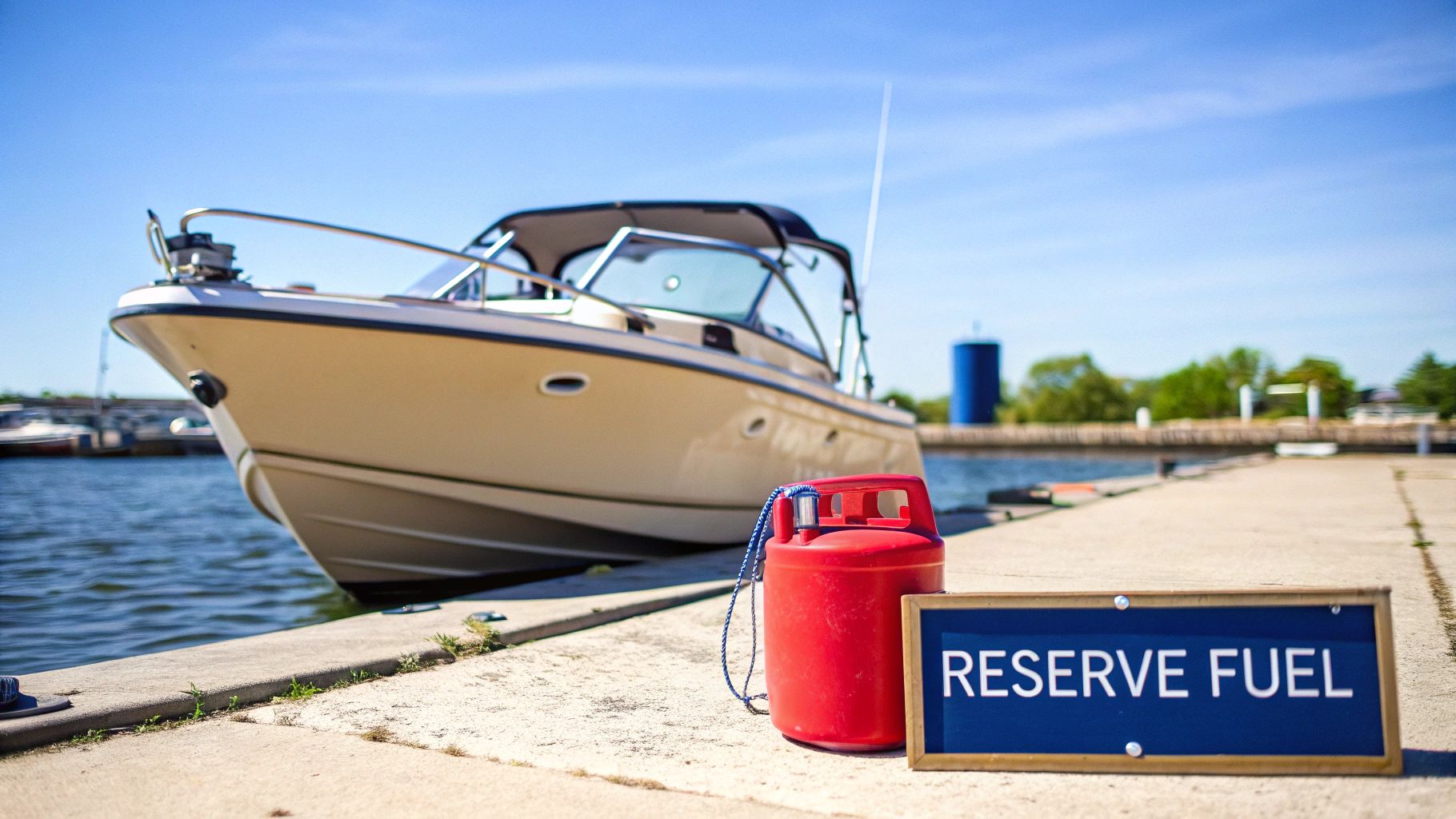
We’ve all been there. You’re miles from the marina, the weather is perfect, the fish are biting, and then you glance at the fuel gauge. It’s way lower than you thought. That’s the exact moment a 10 gallon canister goes from being just another piece of gear to your most valuable asset. It’s the difference between a ruined day and a minor inconvenience.
For most recreational boaters and even some marina crews, this is the size they reach for first. A 5-gallon can often feels like it's not quite enough backup for a full day out, while a 20-gallon drum is just too awkward and heavy for one person to wrestle with safely on a rocking boat.
Hitting the Sweet Spot: Capacity vs. Portability
When full, a 10 gallon gas canister tips the scales at around 60-70 pounds. That’s a weight most adults can manage, whether you’re carrying it down a long dock or lifting it onto the deck. This makes refueling away from the pump a straightforward task, not a back-breaking ordeal. In a marine setting, where things can get tricky fast, that ease of use is a huge deal.
And it’s not just for emergencies. If you keep your boat on a lift or in a slip without a nearby fuel dock, these canisters are a game-changer. Instead of the hassle of moving your boat just for a fill-up, you can simply bring the fuel to it.
The Bottom Line: A 10-gallon can provides a serious fuel reserve—often enough to double the range of a smaller boat—but stays portable enough for one person to handle. That’s why it’s the go-to.
Is a 10 Gallon Canister Right for You?
Deciding on the right size comes down to your boat, your typical trips, and your ability to handle the weight. This quick table breaks down the pros and cons to help you see if the 10-gallon option fits your needs.
| Key Consideration | Advantage | Disadvantage |
|---|---|---|
| Fuel Capacity | Provides a substantial reserve, often a full tank for smaller boats. | Might be overkill for very short trips or tiny boats. |
| Weight & Portability | Manageable for most adults to lift and carry short distances. | Can be heavy and awkward (60-70 lbs) on unstable surfaces. |
| Storage Space | Fits reasonably well in most boat storage lockers or on deck. | Takes up more space than smaller 5-gallon cans. |
| Refueling Time | Fills a boat's tank faster with fewer trips than smaller cans. | The weight can make pouring a bit more challenging to control. |
| Versatility | Excellent for day trips, weekend outings, and emergency backup. | Less practical for quick top-offs or small engines (like dinghies). |
Ultimately, for most small to mid-sized boats, the advantages of having that extra fuel security far outweigh the slight inconvenience of the added weight and size.
A Longtime Staple for Fuel Storage
The 10 gallon gas canister isn’t a new invention; it's been a trusted tool for fuel storage for decades, especially in North America. Big events like Hurricane Sandy back in 2012 really drove home the need for reliable, portable fuel solutions and boosted their popularity among homeowners and boaters alike. If you want to get into the weeds, you can dive deeper into the fuel storage container market and its trends.
This guide is all about giving you practical, real-world advice for handling these canisters safely. Getting it right helps you avoid fines, protect our waterways, and—most importantly—keep yourself safe. We’ll cover everything from picking the right canister to filling, storing, and using it correctly.
Picking the Right 10-Gallon Gas Canister
Choosing a 10-gallon gas canister for your boat isn’t like grabbing one for your lawnmower. Out on the water, you're dealing with saltwater, relentless sun, and constant movement. The can you pick directly impacts your safety and convenience, and it needs to be legally compliant. A cheap, poorly made can could easily corrode, leak, or worse, turn into a pressurized bomb in the summer heat.
Think of it this way: you wouldn't trust a cheap anchor to hold your boat, so why would you trust a flimsy container with 10 gallons of flammable fuel? Taking the time to choose wisely now will save you from some serious headaches down the road.
Plastic or Metal?
The first big choice you’ll face is the material. Both high-density polyethylene (HDPE) plastic and the classic metal cans have their pros and cons, but for use on a boat, one is the clear winner.
For most boaters, a high-quality, marine-rated HDPE plastic canister is the way to go. The biggest reason is simple: corrosion resistance. Metal cans, no matter how well-coated, will eventually start to rust from the constant assault of salt spray and humid air. Plastic, on the other hand, is completely immune.
Modern plastic cans are also incredibly tough. They can handle the inevitable bumps and drops on a busy dock or a rocking deck without denting or being compromised. While a metal can might seem more rugged, one bad dent can weaken a seam and set you up for a future leak.
My Takeaway: I always look for plastic canisters with thicker walls. They might be a little heavier, but that extra material gives you much better protection against punctures and swelling from fuel vapor pressure on a hot day.
Understanding the Labels: Safety and Compliance
This is the part people often overlook, but it's absolutely critical. Your canister must have the right certifications. If it doesn't, you're not just using an unsafe product—you're probably breaking the law.
When you're shopping, keep an eye out for these two key labels on any 10-gallon gas canister:
- EPA (Environmental Protection Agency): This sticker means the container meets federal standards for preventing gasoline vapors from escaping into the atmosphere. It's a non-negotiable, nationwide requirement.
- CARB (California Air Resources Board): This is California’s standard, which is even stricter than the EPA's. Since many other states have adopted these tougher rules, a CARB-compliant can is your best bet for the highest level of vapor containment and is legal to use anywhere in the US.
These certifications are your guarantee that the can has been properly tested and has features like a self-venting, spill-proof spout and a build that minimizes fuel permeation.
Key Features Every Boater Needs
Beyond the basics of material and certifications, a few features make a huge difference when you're actually trying to use the can on a boat.
A truly spill-proof spout is non-negotiable. Many of the newer spouts can be finicky, but a good one will have a locking mechanism that stops fuel from pouring until it's firmly in your boat's fuel fill. This is a game-changer on a rocking boat, where one little slip can send gasoline all over your deck or into the water.
Next up, check the handles. A full 10-gallon can weighs over 60 pounds! Look for designs with multiple, comfortable handles. A top handle is great for carrying with one hand, but a second handle on the back is what gives you the control you need for a smooth, steady pour without throwing out your back.
Finally, a solid venting system is essential. Certified cans have automatic vents that let out excess vapor pressure as temperatures climb, which stops the can from bloating up like a balloon. It’s a crucial safety feature that prevents the container from becoming dangerously over-pressurized in the sun. For an even more detailed look at what to look for, check out our guide to the best marine fuel cans for some more insights.
Choosing the right canister is the first step in a safe fueling routine. When you prioritize corrosion-resistant HDPE, confirm EPA and CARB compliance, and pick features designed for the real world of boating, you’re investing in a piece of gear that will serve you well for years. It's about more than just holding fuel—it's about holding it safely.
How to Fill and Transport Your 10-Gallon Gas Canister Safely
Getting ten gallons of gas from the pump to your boat involves more than just a strong back. Every step, from how you fill the canister to how you secure it on deck, is a link in a safety chain. Get the process right, and you'll manage your 10-gallon gas canister with confidence.
The journey begins at the gas station, and your very first move is a big one. Never, ever fill a portable gas can while it's inside a vehicle, a truck bed, or on your boat. Always place the canister firmly on the ground before you start pumping. This simple action grounds the container and prevents a static electricity spark from igniting fuel vapors—it’s a rare occurrence, but the consequences can be catastrophic.
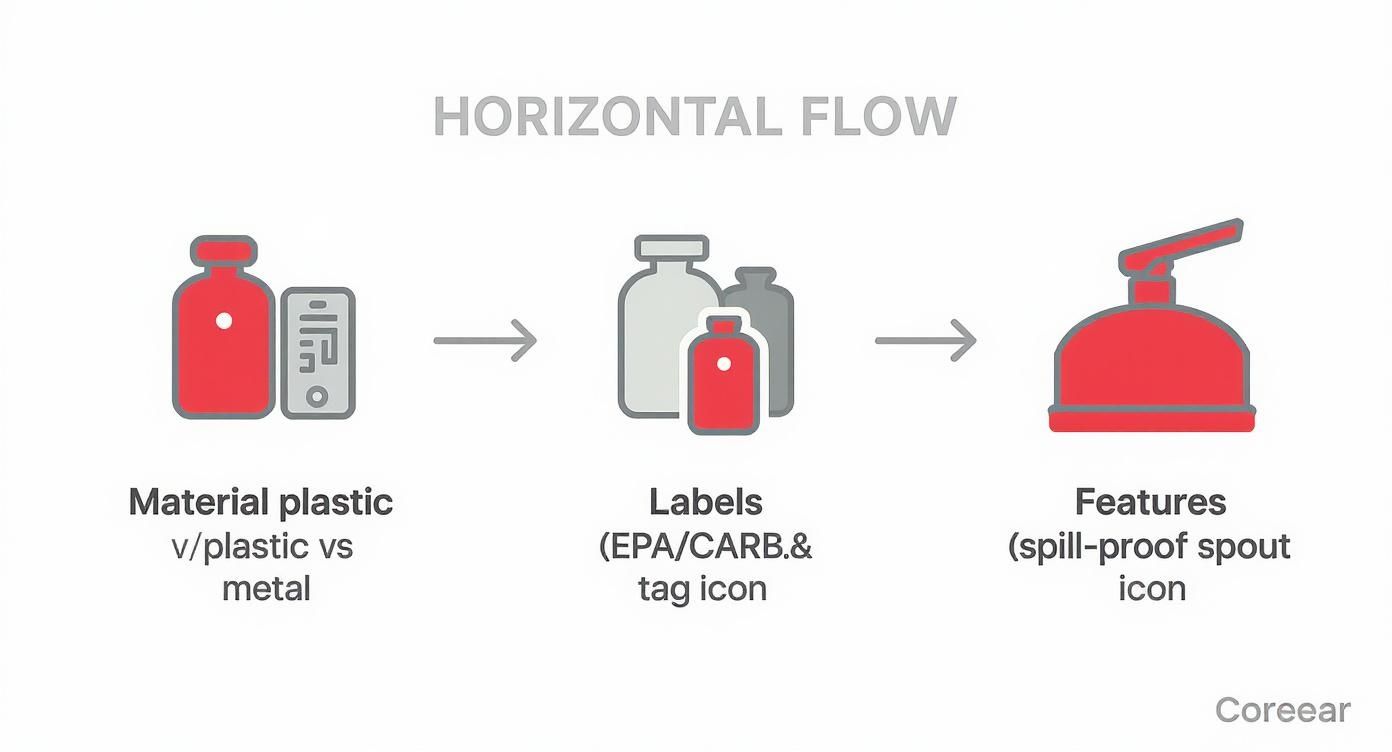
Best Practices at the Pump
With your canister on the ground, stick the nozzle all the way in and start filling at a slow, controlled pace. It’s tempting to use the nozzle’s hands-free clip, but don't. Keeping your hand on the trigger gives you instant control to stop the flow if something goes wrong.
A common mistake is topping the can off to the brim. Gasoline expands when it warms up, and a completely full canister left in the sun can build up a dangerous amount of pressure.
- Leave Room for Expansion: Only fill your canister to about 95% capacity. This leaves a vital air gap, allowing the fuel to expand safely without stressing the container's seams or forcing fumes out of the vent.
- Secure the Cap Immediately: The moment you finish, remove the nozzle carefully to avoid drips and screw the cap on tight. A loose cap is an open invitation for vapors to escape and fuel to spill during the ride home.
A tight cap and a proper air gap are your best friends in preventing spills and vapor leaks. This simple habit stops fuel from sloshing out during transit and gives it room to breathe on hot days, protecting you, your vehicle, and the environment.
Securing the Canister for the Ride
Now that your 10-gallon gas canister is filled correctly, you have to get it to the marina. The goal here is simple: prevent it from tipping, sliding, or baking in the sun. A 70-pound container of flammable liquid rolling around your vehicle is a recipe for disaster.
Place the canister upright in a stable, well-ventilated spot, like the bed of a truck. Use bungee cords or ratchet straps to lash it firmly against the side so it can't budge. If you're using an SUV or a car trunk, find a level spot and wedge it in with other heavy objects to keep it from moving. Critically, you need to crack a window to ensure there’s some airflow. Never leave a gas can in direct sunlight inside a sealed car—the interior temperature can spike, causing a dangerous buildup of vapor pressure.
This whole process is built on decades of design improvements. The modern 10-gallon gas canister owes its heritage to the military "jerry can" from World War II, which was legendary for its toughness. Today’s versions have built on that legacy with features like stronger seams and better handles to make transport safer for all of us.
From the Dock to Your Deck
The last leg of the journey—getting the can from your vehicle onto the boat—demands just as much care. Always lift with your legs and carry the can with both hands.
Once it’s on board, the same rules apply: secure it upright and keep it away from heat sources or potential sparks. Find a spot on deck where the canister can be strapped down, out of the way of foot traffic and far from the engine compartment. Many boaters use dedicated chocks or secure it to a rail. The main thing is to make sure it won’t tip or slide, even if you hit some choppy water. For a closer look at best practices, our guide on https://clixfueling.com/blogs/news/filling-a-gas-container offers even more detail.
Handling the fuel correctly is only half the battle. You also need the right safety gear nearby. For instance, being familiar with DOT-compliant fire extinguisher requirements is non-negotiable when you’re dealing with this much flammable liquid.
Fuel Handling Safety Checklist
To make it even easier, here's a quick checklist to run through every time you handle fuel. Think of it as your pre-flight check before hitting the water.
| Phase | Action Item | Reason |
|---|---|---|
| At the Pump | Place canister on the ground before filling. | Prevents static electricity sparks. |
| At the Pump | Fill to 95% capacity, leaving an air gap. | Allows for fuel expansion in the heat. |
| At the Pump | Secure the cap and vent tightly immediately. | Prevents spills and vapor leaks. |
| Transport | Secure canister upright in a ventilated area. | Stops it from tipping, sliding, or building up fumes. |
| Transport | Keep it out of direct sunlight and sealed cars. | Avoids dangerous pressure buildup from heat. |
| On the Boat | Lash the canister down away from heat/sparks. | Ensures stability in rough water and prevents ignition. |
Following these steps turns a potentially hazardous task into a safe, routine part of your boating prep. A little diligence on land ensures a worry-free day on the water.
Where to Stash Your Fuel On and Off the Boat
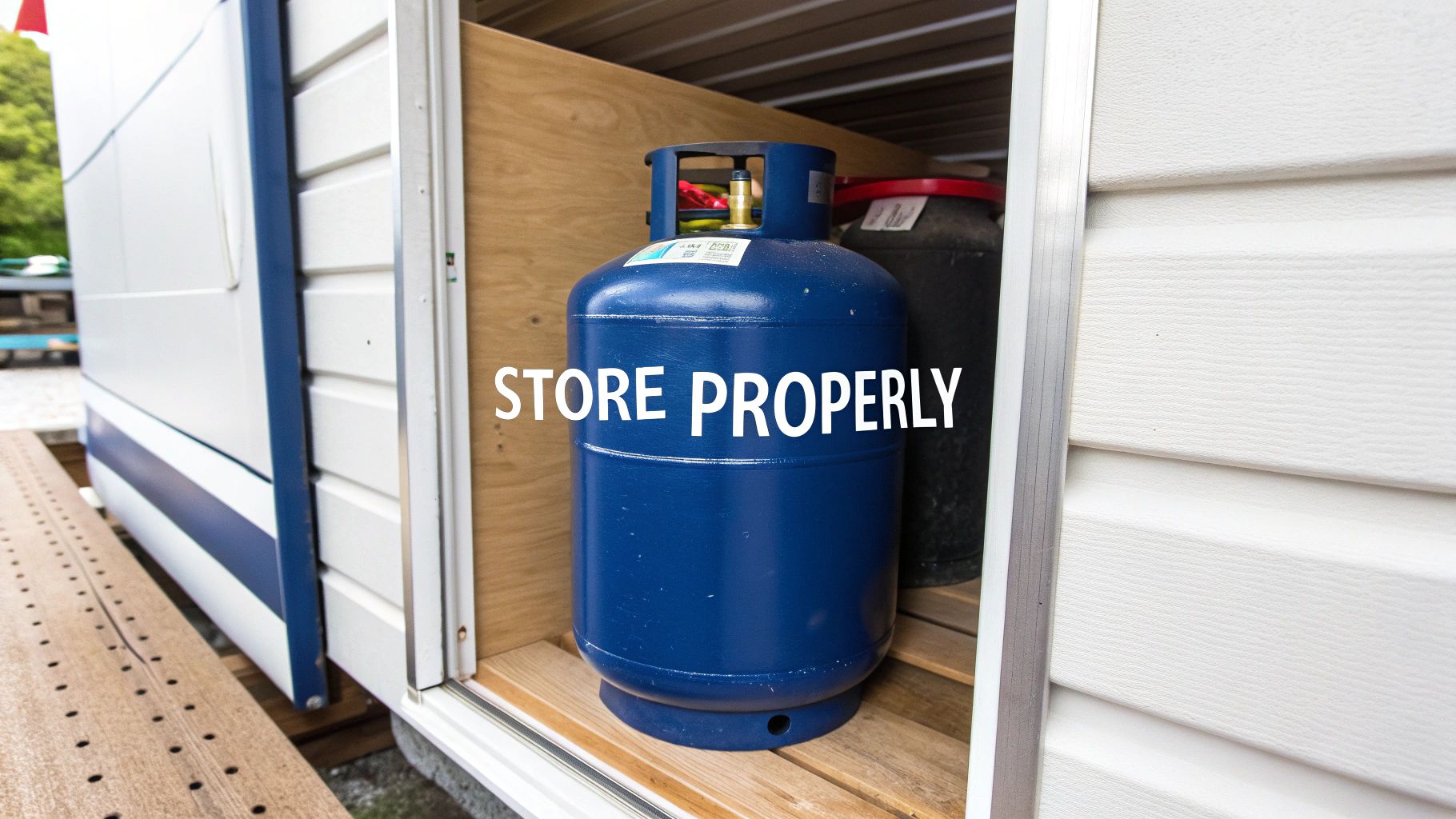
Getting your 10-gallon gas canister to the marina safely is one thing, but knowing how to store it—both on the boat and back home—is just as critical. Gasoline is volatile stuff, and frankly, the invisible vapors are often more dangerous than the liquid fuel itself. Storing it correctly keeps everyone safe and protects your boat’s engine from the gunk that comes from stale fuel.
The golden rule here is simple: find a spot that’s cool, dry, and gets plenty of airflow. This isn't just a suggestion; it's essential whether the can is on your boat for the weekend or tucked away in your garage for the winter. Those vapors need to go somewhere, and you want them to dissipate harmlessly, far away from anything that could ignite them.
Onboard Storage Best Practices
Let's be crystal clear: never, ever store a spare 10-gallon gas canister in an enclosed cabin, the bilge, or the engine compartment. These spaces are perfect for trapping fumes, creating a ticking time bomb. The only safe spot is on deck, preferably in a designated holder or strapped down tight where it’s out of direct sun and gets constant fresh air.
And when I say strapped down, I mean it. An unsecured 70-pound can will become a dangerous projectile in choppy water, and the last thing you want is for it to rupture and spill fuel everywhere.
Pro Tip: Your fuel canister must always be stored upright. Laying it on its side is asking for trouble. It puts stress on the seams and dramatically increases the risk of leaks from the cap or vent. Upright is the only way to go.
Long-Term Storage on Land
Once you're back on dry land, where you store that canister matters. A detached shed or a well-ventilated garage is usually your best bet. The most important factor is keeping it far, far away from any potential ignition source.
Think about what's in your garage. You probably have more spark-producers than you realize:
- Water heaters with pilot lights
- Furnaces or portable space heaters
- Power tools that throw sparks
- Battery chargers and other electrical gear
Gasoline vapors are heavier than air, so they can creep along the floor until they find a spark. A safety buffer of at least 50 feet from any ignition source is the standard recommendation. For a deeper dive, check out our guide on how to store gasoline safely for all the details.
The Critical Role of Fuel Stabilizer
Modern gasoline, especially the ethanol-blended E10 most of us use, starts to go bad surprisingly fast. We're talking as little as 30 days. As it breaks down, it forms sticky gums and varnishes that will happily clog your fuel lines, injectors, and carburetor. That leads to rough engine performance and repairs that are anything but cheap.
This is where a good fuel stabilizer becomes your engine's best friend. Before you store that 10-gallon canister for more than a month, pour in the recommended amount of stabilizer. It stops the fuel from breaking down and keeps it fresh for a year or even longer. It’s a tiny investment that protects the big one: your boat’s engine.
Canister Check-Ups and Maintenance
Treat your fuel can like any other piece of critical safety gear. It needs a quick inspection before you use it, and especially before you put it away for long-term storage.
Your Pre-Storage Checklist:
- Check for Damage: Give the whole can a once-over. Look for cracks, deep gouges, or fading plastic from sun damage. Pay close attention to the seams and the base.
- Inspect the Seals: Take a look at the rubber gasket inside the cap and around the spout. If it’s brittle, cracked, or worn out, it won’t seal properly.
- Test the Cap and Spout: Make sure the cap screws on smoothly and cinches down tight. Work the spout mechanism to ensure it opens and closes freely without sticking.
If you find any issues, it's time for a new can. A compromised fuel container is a risk you can’t afford to take. A little bit of care will ensure your 10-gallon gas canister serves you safely and reliably, season after season.
Understanding Fuel Transport Laws and Regulations
https://www.youtube.com/embed/jjHLlutss8k
When you’re hauling a 10-gallon gas canister, you're carrying more than just fuel—you're carrying a serious responsibility. The rules for transporting gasoline aren't just red tape; they're there to prevent fires, protect the water we all love, and keep people safe, both on the road and at the marina.
It might seem like a lot to remember, but the basics are pretty simple. This is why you'll hear experts like us constantly talking about using certified containers. An EPA or CARB-compliant can isn't just a suggestion; in many places, it's the law. Trying to save a few bucks on a non-approved container can end up costing you in hefty fines, not to mention the massive risk of a dangerous spill.
Navigating Road and Waterway Rules
The moment you put that 10-gallon gas canister in your car or truck, you're on the Department of Transportation's (DOT) turf. Luckily, for personal use, the rules aren't as intense as they are for commercial haulers. Still, the core safety principles are the same: the container must be secured upright, have good ventilation, and stay out of direct sunlight or extreme heat.
Things shift a bit once you get to the dock. Out on the water, you're in the U.S. Coast Guard's jurisdiction. They have specific rules about carrying extra fuel on recreational boats, mainly focused on preventing gas fumes from building up in enclosed areas and making sure the cans won't tip over if the water gets choppy.
Key Takeaway: The law treats a portable fuel can as a potential hazard, plain and simple. Your job, whether you're on the highway or the waterway, is to handle it in a way that minimizes any risk of leaks, spills, or fires.
Your Environmental Responsibility
This goes beyond just following the rules. Being a responsible boater means being a good steward of the environment. A small gasoline spill can cause an incredible amount of damage. Fuel is toxic to marine life, from fish and birds to the tiny plants that are the foundation of the entire ecosystem.
It’s shocking, but a single gallon of spilled gas can contaminate up to one million gallons of water. It creates that ugly rainbow sheen that suffocates aquatic life by blocking sunlight and oxygen.
This is where you come in. Simple habits like making sure your canister's cap is on tight, pouring slowly, and never overfilling your boat's tank can make all the difference. A good spill-proof nozzle is worth its weight in gold, preventing those little drips that seem harmless but add up quickly.
Responding to a Small Spill
Even the most seasoned boaters have mishaps. If you do have a small spill while refueling from your 10-gallon gas canister, knowing the right steps to take immediately is critical.
Here’s what to do if a small spill happens:
- Stop the Source: First thing's first—stop the fuel from flowing.
- Contain It: Grab absorbent pads or a boom to surround the spill on the water or soak it up on the deck. Whatever you do, don't use dish soap. It just breaks the fuel into smaller droplets and sinks it, causing even more damage underwater.
- Soak It Up: Let the absorbent materials do their job and pull the fuel out of the water or off the deck.
- Dispose of It Properly: Put the used pads into a sealed, heavy-duty plastic bag. Never, ever toss them in a regular trash can or into the water.
- Report If Needed: You might not need to report a tiny spill on your deck, but any spill that leaves a visible sheen on the water must be reported to the National Response Center.
Keeping a spill kit on board—with absorbent pads, gloves, and disposal bags—is one of the smartest things you can do. It prepares you to act fast, limit the damage, and stay on the right side of the law.
Common Questions About 10 Gallon Gas Canisters
Even the most seasoned boaters run into questions when dealing with fuel. It's just part of the game. Whether you've been on the water for decades or you're just getting your feet wet, getting clear, straight answers about your 10 gallon gas canister is what keeps you safe and confident. I've heard just about every question in the book, so I've put the most common ones here with practical advice drawn from years of experience.
Think of this as your go-to cheat sheet. It builds on the safety basics we've already covered and gives you the essentials right when you need them.
How Long Can I Actually Store Gas in a Canister?
This is probably the number one question I get. How long can that 10 gallon gas canister sit in the shed before the fuel inside turns into a problem for your engine? The answer hinges on one simple, non-negotiable step: using a fuel stabilizer.
Modern gasoline, especially the E10 blends you find everywhere, has a surprisingly short shelf life. If you do nothing, it can start to go bad in as little as 30 days. The fuel oxidizes, creating gummy varnish that's just waiting to clog up your fuel lines, filters, and carburetor. That’s a fast track to poor performance and a hefty repair bill.
The good news is, adding a quality marine fuel stabilizer changes the game completely.
- With Stabilizer: When you treat the gas properly, it can easily last up to a year, sometimes even longer depending on the specific product. A good stabilizer stops oxidation in its tracks and prevents "phase separation"—that nasty process where ethanol sucks up water and drops it to the bottom of your can.
- Without Stabilizer: After about a month, that fuel is already losing its punch and forming those harmful deposits. Pouring old, untreated gas into your boat is a gamble you don't want to take.
My Pro Tip: The moment you fill a canister, grab a permanent marker and label it. Write down the date and whether you added stabilizer. It's a two-second habit that saves you a world of guesswork and protects your engine.
Can I Use My Gas Can for Diesel?
I hear this one a lot, and the answer is always a hard and fast no. Never. Using the wrong can for a specific fuel isn't just a bad idea; it's incredibly dangerous and can completely wreck an engine.
There's a universal color-coding system for fuel cans for this exact reason. Burn it into your memory—it's not optional.
The Fuel Canister Color Code
- Red: For gasoline. Only gasoline.
- Yellow: For diesel fuel. Only diesel.
- Blue: For kerosene.
This isn't just bureaucracy. Putting diesel in a gas engine (or the other way around) will cause catastrophic damage. Beyond that, a red 10 gallon gas canister is built with materials and seals designed specifically to handle gasoline's unique chemical makeup and its highly volatile vapors. A yellow diesel can just isn't designed for that.
How Do I Get Rid of an Old Gas Canister?
Everything has a shelf life, including your fuel can. Sun exposure makes the plastic brittle, seals crack and dry out over time, and a good drop can cause hairline fractures you might not even see. Once a can is damaged, leaky, or just plain old, it’s time for it to go. But you can't just chuck it in the recycling bin.
Because it once held a hazardous material, an old fuel can is considered hazardous waste. Tossing it out with the regular trash is illegal and terrible for the environment.
Here’s how to do it the right way:
- Find Your Local Drop-Off: A quick search for your town or county's "hazardous waste disposal facility" or "household hazardous waste collection event" is the first step.
- Follow Their Rules: Every facility has its own process. Most will insist the can is completely empty of fuel and vapors. The best way to do this is to leave the cap off in a well-ventilated spot outside—far from any house, grill, or other ignition source—for a few days until it's bone dry.
- Take It In: Once it's clean and dry, drive it over to the facility during their operating hours. They'll take it from there and make sure it's disposed of properly.
Whatever you do, don't try to burn an old can or hide it in a landfill. Taking a few extra minutes to handle it correctly is a core part of being a responsible boater. Clearing up these common questions helps take the uncertainty out of the equation, making sure you handle your 10 gallon gas canister with safety and skill every single time.
For boaters looking to eliminate the stress and guesswork of refueling altogether, CLiX Fueling Solutions offers a smarter way. Our system prevents spills by automatically shutting off the fuel flow when your tank is full, protecting your boat, your wallet, and our waterways. Discover a spill-free fueling experience.

